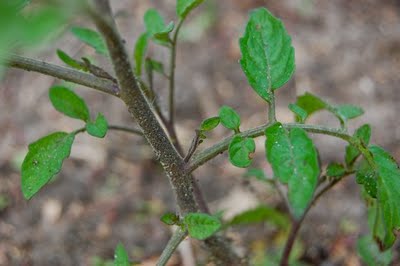
My tomato plants have benefited from frequent rain in their first month outdoors. The moist conditions have encouraged lots of stem and leaf growth, and some flower clusters have set fruits. Now we need a few weeks of warm sunny days to bring out more flushes of flowers and strong clusters of tomatoes. The lush growth has also increased the number of suckers growing from leaf axils, and now is the time to decide how much to prune and which suckers to let remain to mature into fruit-producing stems.
Before pruning out suckers, it’s important to know if the tomatoes are determinate or indeterminate plants. Determinate tomato vines have a limited growth and will stop extending their stems when they achieve full size. (You’ll know they’ve reached their limit when they produce a cluster of flowers, but no leaves, at the top-growing tip of the main stem.) Their fruits ripen within a short period, and that’s convenient if you need full baskets of tomatoes all at one time for processing into something delicious. Determinate tomatoes will have few suckers; for best harvest allow them to remain.
My Mighty Sweet Hybrid grape tomato is a determinate plant that will grow three to five feet (90 cm to 1.5 m) tall, and be ready to harvest 55 days after transplanting into the garden. The two-ounce (57-g) grape tomatoes will probably all ripen within 14 days, and then the plant will be finished producing fruit. Determinate plants like Mighty Sweet Hybrid can be pulled when finished production, leaving space for a fall planting of another vegetable.
The suckers on indeterminate plants, however, need to be controlled by pruning. Indeterminate tomato vines continue producing flowers and fruit until the plant is killed by frost. The vines will attempt to grow suckers from almost every leaf axil, each sucker quickly producing flowers and fruits as it matures into a full-size stem. Most gardeners allow one or two suckers low down under the first set of flowers to remain and develop into stems. The main stem and any selected suckers will all require some sort of support for the weight of their fruits. You can use tomato cages or tie the stems to individual stakes.
My Fourth of July tomato is indeterminate, and will reach its first harvest in 49 days, and then continue to extend its stems until frost. It’s growing in a large container, and I’ve decided there’s room for only one sucker in addition to the main stem. If the plant were in the ground, I’d allow two suckers to remain.
When indeterminate plants are left unpruned, they become a roiling mass of vines that no form of cage or staking can control. The weight of foliage and fruit soon overwhelms the central structure, and the whole thing tumbles down and sprawls in a heap. Many fruits are damaged by slugs, or caused to rot by contact with soil.
Indeterminate tomatoes have wonderful energy, and I expect to be pruning suckers every week on that Fourth of July plant. If I had a reason for wanting more plants, I could easily root these first early suckers. (Suckers taken later in the season wouldn’t have time enough to grow.) To root a tomato sucker, fill a clean four-inch (10-cm) pot with soilless mix and poke a deep hole in the centre with a pencil. Select a sucker that’s six to eight inches (15 to 20 cm) long, and sever it from the leaf axil with a clean razor blade. Remove all but the top two or three leaves, and dip the cut end in powdered rooting hormone if you have it. Set the bottom half of the cutting into the prepared pot, firm the soilless mix around the stem, and water well (don’t use any plastic bag or covering around the pot). Place the pot in the shade out of the wind, keeping it watered, and watch for new growth after two to three weeks. (If the top leaves wilt severely, the cutting has failed.)
These little seedling tomato plants can be set into the garden, and will begin producing fruit in late summer. They could also be used for greenhouse or indoor growing.

Sadly, the groundhogs running wild in North York this year brutally pruned my heirloom tomatoes , so I don’t have to worry about suckers. Any advice on groundhogs?
Hi Craig, a nice trick from my neighbour (it helped in my garden): find an entrance hole and place a mirror in front facing the hole.
Hope it helps you, too.
Hi Craig,
I have the same problem with a groundhog in the garden (also in North York). I’ve tried every kind of solution, including phosphorus bombs in the burrow! But that guy just can’t be beat on his own turf. I’m growing my tomatoes in containers on the deck, and so far he hasn’t ventured up the steps. Dogs will usually keep groundhogs off, but I don’t have a canine friend. Perhaps you could borrow one for a couple of weeks, just to make a statement? Good luck.
– Judith
I put used cat litter down the burrow hole, so far the groundhog has not returned. Maybe it helps that the neighbor lady is leaving fruit outside for the varmint. But anyway it’s gone!